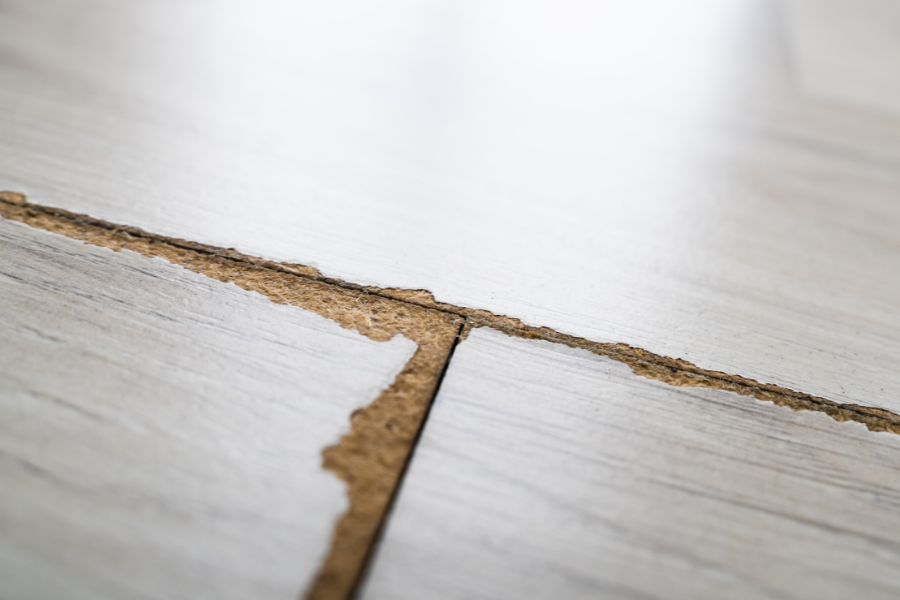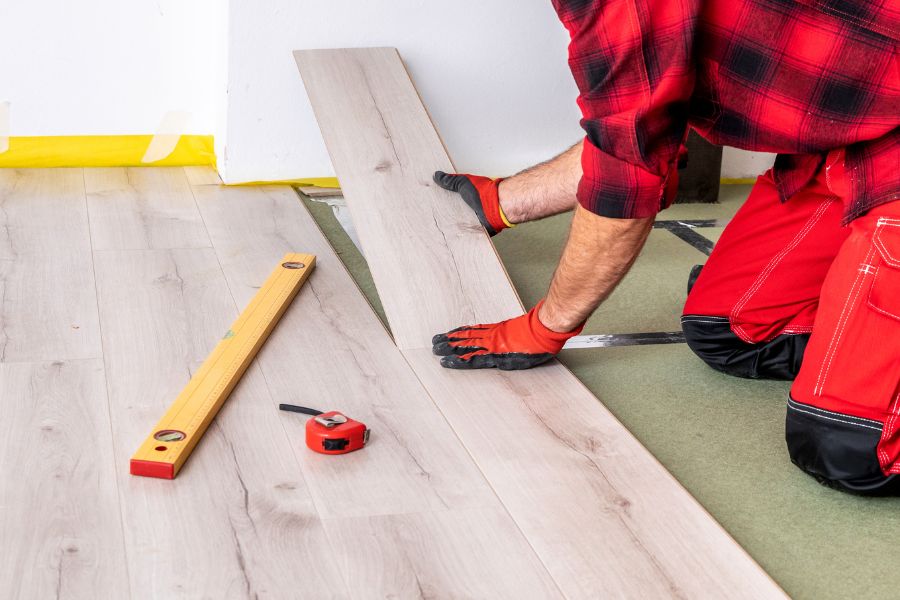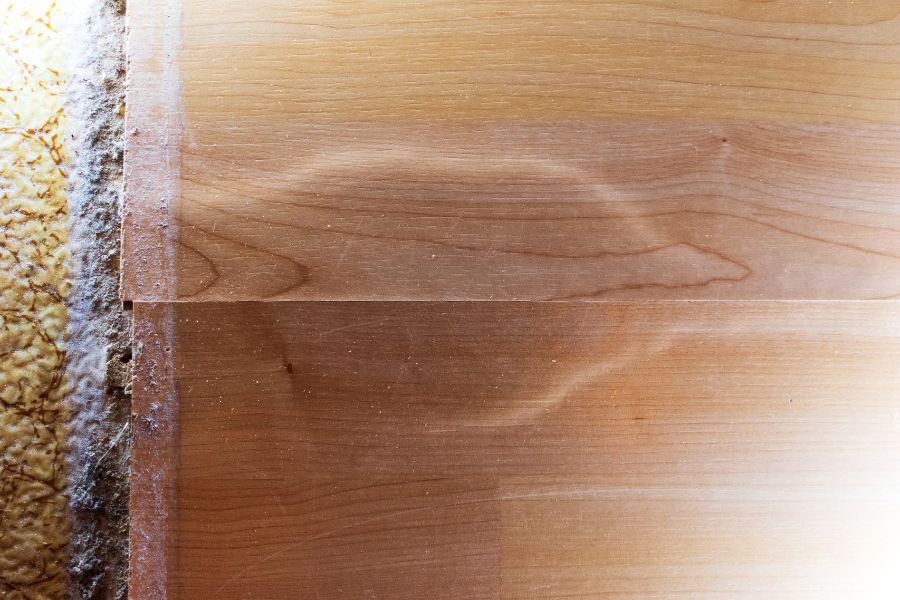Flooring Tips, Laminate Flooring
What To Do When Your Laminate Floors Are Raising
If you’re a homeowner, you know that homeownership has its ups and downs. Sometimes, we find our laminate floors lifting, and oh boy, it can be frustrating!
Did you know that raised laminate affects approximately 15% of installations? There are common reasons for this occurrence, including too much moisture, poor installation, uneven subfloors, and missing expansion gaps.
Are your laminate floors lifting and you don’t know what to do about it? Don’t panic! We’re here to help. We’ll guide you from finding the problem to fixing it. We’ll make sure your laminate floors are looking as good as the day you brought them home from the store.
Did you know moisture over 6-9% can cause laminate floors to lift? Or that bad installation can cause big gaps? We know that these issues can be a real problem.
But there’s no need to worry because our flooring professionals know how to deal with bouncy boards and tricky gaps. At Flooring Liquidators, we’re laminate flooring experts, and we’re ready to share our special knowledge with you. Let’s fix those flooring issues together!
Understanding the Causes of Lifting Laminate Floors
At our laminate flooring store, we’ve seen customers experience many laminate flooring problems, and we’re here to be the light at the end of the tunnel. As a homeowner, it’s incredibly important to know what causes your floors to lift. We’re here to explain why this happens!
Excess Moisture: The Silent Culprit
Think of laminate floors as Batman, and moisture as The Joker – moisture is the main enemy of laminate floors. Moisture is the number one cause of floor lifting. This is especially true in places like bathrooms and kitchens which typically have more humidity than other areas. When moisture gets into your floors, it makes the planks swell and buckle. This leads to the floor lifting up.
Improper Installation Techniques
Installing laminate floors incorrectly is another big reason for lifting floors. When you need a floor installation, choose the team at Flooring Liquidators to ensure your floors are installed properly from the beginning! Many people, even those doing it themselves, forget to leave enough space for expansion or put the underlay in the wrong spot. These mistakes can cause big problems later. That’s why we always suggest professional installation. It helps avoid these common mistakes.
Uneven Subfloor Issues
Imagine trying to build on ground that won’t stop shaking. This is exactly what an uneven subfloor is like. It’s a big problem. Concrete subfloors need a damp-proof membrane to prevent any moisture from getting in. Without this, your laminate floor will end up looking like the Mighty Canadian Minebuster roller coaster at Canada’s Wonderland! Choosing good quality laminate flooring with an AC3 rating or higher can help with some of these issues, but even the best flooring can’t fix poor installation or moisture problems.

Identifying the Signs of Laminate Floor Lifting
We know that spotting laminate floor problems can cause you to worry. But, remember that catching raised flooring signs early allows you to get them fixed before they get even worse. Let’s look at the signs that show your laminate flooring might be having issues.
First, watch for gaps between the planks. If your floor looks like a puzzle that doesn’t fit together quite right, it’s a big sign. Also, if some areas are buckling or warping, that’s another warning.
When your floor starts to feel like you’re riding an amusement park ride, that is a sign. Your floor should feel straight and smooth to walk on. Warping is not fun for walking, but it’s not good for your laminate floor either.
Do you feel like you’re walking on a trampoline? That’s also not a good sign. Floors that are unstable when you walk on them often indicate the laminate is lifting. In the worst cases, you might see planks pulling away from the floor below. That’s a big problem!
- Visible gaps between planks
- Buckling or warping in specific areas
- Uneven or bouncy surfaces
- Planks separating from the subfloor
It’s incredibly important to spot these signs early on. By acting fast, we can stop the problem from getting worse. So, make sure you stay alert, pay close attention to your floors, and watch for these signs. Your wallet and your feet will appreciate it!
The Impact of Humidity on Your Laminate Flooring
Have you ever walked outside on a summer day and felt like the air was so thick you could cut it with a knife? That same humidity can damage your lovely laminate floors. Let’s explore how moisture affects your home’s foundation.
Seasonal Changes and Floor Expansion
Laminate flooring changes with the seasons, just like a moody teenager. In warm, humid weather, your floor can swell, giving it a crowned look. But dry, cold weather can cause it to shrink, leaving big gaps.
If the humidity level goes above 55%, moisture can get into the wood, making floorboards swell. To ensure your floors stay safe from humidity and stay looking great, keep humidity between 35% and 55%.
Importance of Proper Acclimation
If you’ve ever owned a fish tank, you know that you have to let your new fish acclimate to the tank temperature before completely putting it in, or it can cause harm to the fish. Well, laminate floors need to follow the same process! Let your new laminate get used to your home’s climate before installing it. This step is key to avoiding flooring expansion problems.
If you want to ensure your home is kept around the right humidity levels, think about getting a humidistat or hydrometer. These tools help you monitor the air’s moisture. If you find there is too much humidity in your home, use a dehumidifier or turn up the AC. Your laminate will stay in place and look great for years.
Essential Tools for Fixing Raised Laminate Floors
Have you ever seen your laminate flooring lift up? It’s not only unsightly but can be dangerous too. But don’t worry, with the right tools, you can fix it easily. Let’s look at the key equipment you’ll need to fix your floors.
Start with a quality utility knife. Utility knives are great for cutting out damaged planks without damaging the rest. If you need to, you can use a hammer and chisel for any spots that require extra care.
The next tool you’re going to need is a moisture meter. This tool identifies moisture in the subfloor, helping you solve the real issue. It’s a big help!
- Rubber mallet and tapping block
- Wood glue for reattaching loose planks
- Vacuum cleaner for post-repair cleanup
- Replacement planks (just in case!)
- For bigger repairs, think about a circular saw with a fine-finish blade. This is perfect for cutting out damaged areas or fitting around pipes and corners.
Having the right tools is crucial to fixing your floors. With a toolbox full of all the correct tools for the job, you’ll feel like Bob The Builder! Can you fix it? Yes, you can!
Step-by-Step Guide to Fixing Uneven Subfloors
Uneven subfloors are one of the biggest problems for homeowners and flooring experts to deal with. At Flooring Liquidators, we’ve seen everything from small dips to big drops in the subfloor when working on floor replacement projects. Let’s get into the details of fixing subfloors and preparing for smooth laminate flooring installation.
Assessing the Subfloor Condition
The first step is to lift up the affected laminate sections. Take a close look to identify the real condition of your subfloor.
Sanding and Leveling Techniques
For plywood or OSB subfloors, sanding is usually the best choice. We use a heavy-duty sander to fix high spots. Sometimes, we add support with 2″x4″ pieces for low areas. If the subfloor is made of concrete slabs, a self-leveling compound works best. Mix it as the package says and pour it over all the uneven spots.
Applying Underlayment for Added Protection
After fixing the big issues, it’s time for underlayment. This step smooths out small imperfections and gives your new flooring a solid base. Remember to always prime the subfloor first, but use different primer ratios for concrete and wood.
With all the prep done, you’re set for a perfect laminate flooring installation. Remember, the hard work pays off – we’ve had to remove laminate flooring multiple times because of uneven subfloors! Take your time, follow these steps, and soon you’ll be enjoying smooth, even floors.

Addressing Moisture-Related Laminate Floor Issues
As mentioned above, moisture is a big problem when it comes to laminate flooring. It can be really frustrating to deal with. Let’s look at some easy ways to fix this issue and keep your floors looking great.
The first thing you need to do is find where the moisture is coming from. Is there a hidden leak or just too much humidity? Once that is figured out, it’s time to start fixing it. Here’s what we suggest:
- Remove the affected flooring sections
- Add a moisture-resistant underlayment
- Use a moisture meter to check levels before reinstalling
Laminate flooring is like a sponge. It’s made of wood fiberboard, so it can easily be damaged by water. That’s why it’s important to act quickly when you see moisture damage.
If you’re not sure what to do, don’t worry! At Flooring Liquidators, we’re your local laminate flooring store, and our experts can offer great advice and products. Don’t hesitate to reach out to us for any advice or assistance!
In serious cases, it might be best to get professional help from our installation team. We can make sure the moisture is fixed and your flooring is installed right. Protecting your flooring is a smart move, and it’s worth the cost.
The Crucial Role of Expansion Gaps in Laminate Floors
Expansion gaps are key in laminate flooring installation. They might seem small, but they’re crucial for your floor’s health.
Proper Gap Measurement and Maintenance
For most laminate floors, we suggest an expansion gap of 3/8 inch around the edges. This space lets your floor adjust to temperature and humidity changes. Without it, your floor might buckle or squeak, which is not what we aim for!
Spacers are essential for getting those gaps right. These small plastic wedges come in packs of 30 or more, made just for laminate floors. They keep your planks in line and maintain the necessary space.
Retrofitting Expansion Gaps in Existing Floors
If your floor was installed without gaps, don’t worry. It can be fixed, but it’s a bit of work. You’ll need to take out all the boards, trim them, and put them back with the right spacing. It’s best done with professional help to avoid problems later.
Laminate flooring changes size with the environment. By giving it space to move, it can continue to look amazing for years to come. So, remember those important expansion gaps when planning your flooring project!
When to Consider Professional Help for Your Laminate Floors
We love tackling DIY projects, but sometimes our laminate floors need a pro’s help. If you’ve tried fixing your floors and they’re still not right, it’s time to call a professional. The experts can handle complex issues that stump you.
When you’re dealing with a severely uneven subfloor, it’s a job for pros to tackle. Moisture damage? We can fix it. These problems need special tools and skills that most homeowners don’t have. That’s why you can trust the professionals at Flooring Liquidators to get it done right.
For big projects in homes or businesses, getting professional help is a must. We ensure the right installation and lasting results. Remember, laminate flooring is popular for its looks and toughness. But, it needs the right care to stay looking great.
Here’s when to call for help:
- Your floors are raising or buckling
- You see signs of water damage
- The subfloor feels uneven
- You’re dealing with stubborn stains or deep-seated dirt
When it’s time to call in the pros, get in touch with our team at Flooring Liquidators. We’re the laminate flooring store you can trust, and our expert floor installation team will ensure your floor looks amazing!
Preventative Measures to Keep Your Laminate Floors Flat
We’ve all seen it happen – your new laminate floors start to lift. But don’t worry, we have some great tips to keep them looking great. First, let’s talk about humidity. It should be just right, not too high or too low. Keeping humidity steady is important for your laminate floors.
If you live in a damp area, think about getting a dehumidifier. You can get one at your local Canadian Tire, Home Depot, or Walmart! It helps keep your floors in top shape. It’s like giving your floors a spa day!
Next, let’s discuss installation. It’s important to let your laminate adjust to its new place before it settles. This is like letting your tea cool down before drinking it. And remember, those gaps around your floors are there for a reason – they allow your floors to expand and contract naturally.
Checking your floors regularly is also key. It’s like a health check-up for your laminate. Catching any issues early can save you a lot of trouble later.
Cleaning your laminate floors is an art. Use just the right amount of cleaner to avoid streaks. It’s all about balance, like making the perfect cup of coffee. Don’t soak your floors with water; it’s not good for them. Stick to light, damp mopping to keep them looking great.
Remember, taking care of your laminate floors is easy. Follow these tips, and your floors will stay flat, look fabulous, and be ready for anything!
Need help with your laminate floors or looking for a completely new laminate floor installation? Get in touch with our team of incredible installers today! At Flooring Liquidators, we work with you to find you the perfect floors for your needs, and bring your vision to life right in your home. We have 16 locations across Ontario – find the location nearest to you!


